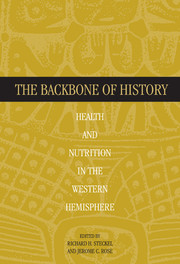Book contents
- Frontmatter
- Contents
- Preface
- List of Contributors
- PART I
- PART II METHODOLOGY
- 2 Reconstructing Health Profiles from Skeletal Remains
- 3 A Health Index from Skeletal Remains
- 4 Paleodemography of the Americas: From Ancient Times to Colonialism and Beyond
- PART III EURO-AMERICANS AND AFRICAN-AMERICANS IN NORTH AMERICA
- PART IV NATIVE AMERICANS IN CENTRAL AMERICA
- PART V NATIVE AMERICANS AND EURO-AMERICANS IN SOUTH AMERICA
- PART VI NATIVE AMERICANS IN NORTH AMERICA
- PART VII
- PART VIII
- PART IX EPILOGUE
- Index
3 - A Health Index from Skeletal Remains
Published online by Cambridge University Press: 01 March 2010
- Frontmatter
- Contents
- Preface
- List of Contributors
- PART I
- PART II METHODOLOGY
- 2 Reconstructing Health Profiles from Skeletal Remains
- 3 A Health Index from Skeletal Remains
- 4 Paleodemography of the Americas: From Ancient Times to Colonialism and Beyond
- PART III EURO-AMERICANS AND AFRICAN-AMERICANS IN NORTH AMERICA
- PART IV NATIVE AMERICANS IN CENTRAL AMERICA
- PART V NATIVE AMERICANS AND EURO-AMERICANS IN SOUTH AMERICA
- PART VI NATIVE AMERICANS IN NORTH AMERICA
- PART VII
- PART VIII
- PART IX EPILOGUE
- Index
Summary
ABSTRACT
This chapter describes the data used for the Western Hemisphere project, discusses the format in which the information was coded, and explains the health index, which is a method for measuring and comparing health status using skeletal remains. Skeletal lesions measure primarily chronic health conditions, but they can reflect acute infections to the extent that they affect physical growth, the formation of linear enamel hypoplasias, and other conditions that register on bones. The database contains measurements of seven basic health indicators from12,520 skeletons of people who lived in North, Central, or South America over the past 7 millennia. For purposes of analysis, many of the 218 sites where people lived were combined into 65 sites based on ecological and chronological similarity. The health index adjusts for the age distribution of the population and incorporates the severity of lesions indicating biological stress. The current (Mark I) version of the index gives equal weight to the health indicators, but this assumption and others explained in the chapter could be modified based on additional research. The Mark I health index could also be readily adapted to incorporate length of life. The index rankings reveal considerable diversity in health status, with Native Americans being among the most but also among the least healthy groups who lived in the Western Hemisphere prior to the end of the nineteenth century.
Social scientists have devised many approaches to measuring the standard of living. Economists use national income accounts and related measures, such as gross national product per capita, to depict material aspects of the quality of life.
- Type
- Chapter
- Information
- The Backbone of HistoryHealth and Nutrition in the Western Hemisphere, pp. 61 - 93Publisher: Cambridge University PressPrint publication year: 2002
- 53
- Cited by



